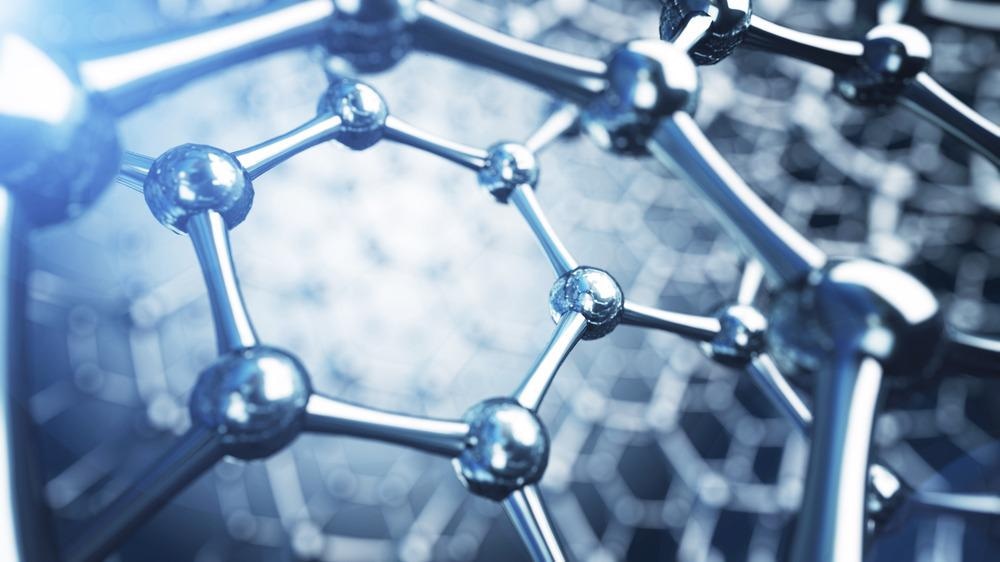The thermal rectification of pristine graphene was explored in a recent work published in the journal Carbon. Two-dimensional graphene was reinforced by a hybrid platform comprising SiO2 and GaN alternatively.

Study: Thermal rectification effect of pristine graphene induced by vdW heterojunction substrate. Image Credit: Egorov Artem/Shutterstock.com
Thermal rectification (TR) is employed in a range of complicated asymmetrical or heterogeneous systems as an efficient technique of thermal control.
Graphene for Heat Dissipation Applications
With the fast expansion of semiconductor devices and the continued shrinking of microelectronics, energy dissipation is becoming the key limiting factor in future technology's performance gains.
Due to its ultra-high heat capacity, graphene has been extensively employed in the heat removal design of numerous technologies and appliances. As graphene is a nanoscale monoatomic substance, its physical characteristics are very responsive to environmental influences.
As a result, graphene's heat capacity can be dynamically adjusted.
Thermal Rectification (TR) Using Graphene
Substantial research has been undertaken on the modification techniques of heat transport in graphene, such as dislocations, flaws, asymmetrical architecture, and substrate influence, among other things. Further investigations have found that when these modification steps for graphene's heat capacity are implemented, the heat fluctuation inside the material has a strong orientation, essentially maintaining the normal heat conduction ability in one direction while greatly suppressing heat transfer in the reverse direction.
The thermal rectification phenomenon takes place because the controlled carriers in graphene and other semiconductors are no longer electrons but phonons.
Importance of 3D Substrates
Two-dimensional compounds such as graphene are often unstable, and the applicability range of isolated monolayer two-dimensional compounds is restricted; hence they are typically utilized in conjunction with a three-dimensional platform. By changing the rigidity of the substrate, graphene can generate outstanding thermal rectification.
Many investigations have shown that the presence of a substrate alters the characteristics of two-dimensional materials significantly.
It has been demonstrated that when graphene is put over SiO2, Cu, or GaN, the heat transfer is lowered by 80%, 44%, and 10%–17%, respectively. The transfer of phonons via the surface, as well as the high dispersion of bending mode phonons by the interface, are the key causes of this phenomenon.
Limitations of Previous Research on TR
Existing TR experiments all use a normalized temperature gradient, which signifies that the cold source end relating to the structural system frequently requires a very low temperature (200K), which does not match the real-world environment in which the instrument is used. The resulting TR effect needs modifications.
These issues have become significant impediments to the adoption of TR. In brief, since the emphasis of TR studies has moved to non-destructive techniques, it has become critical to quantify the TR of graphene under the effect of substrates and high temperatures.
Current Research Methodology
Employing non-equilibrium molecular dynamics (NEMD) calculations, the researchers investigated the TR impact of graphene tiled over a hybrid platform in this study.
The vdW heterostructure consisting of SiO2 and GaN was chosen as the substrate because of the differences in the underlying effects of SiO2 and GaN on graphene.
300K was chosen as the low-temperature heat source. It was seen that TR could be produced by modifying various substrates in the absence of asymmetrical architectures or surfaces while keeping the same thermal area, and a TR rate of 50% can be achieved.
Conclusion and Prospects
This research suggested an easy-to-implement approach to thermal rectification.
The thermal rectification phenomena of the pure graphene covering the top half of the substrate may be induced by forming a heterostructure through combining various substrates. The findings reveal that when the temperature of the heat source rises, the thermal rectification rises at first, then remains stable.
Furthermore, it was discovered that when the longitudinal range of the thermal bath was raised, the thermal rectification rate initially increased, then reduced, and finally vanished at 5 nm.
Thermal rectification is induced by differences in the graphene localization's heat and size responsiveness, as well as differences in atomic vibration signals on both sides owing to differing substrate influences.
This study presents a simpler method of thermal rectification that does not degrade the graphene structure, as well as a re-evaluation of the impact of thermal rectification at high temperatures, and may act as a guideline for future graphene thermal dissipation system research.
Continue reading: Why AFM Is Critical To Graphene Research.
Reference
Chen, G. et al. (2022). Thermal rectification effect of pristine graphene induced by vdW heterojunction substrate. Carbon. Available at: https://www.sciencedirect.com/science/article/abs/pii/S0008622322000124
Disclaimer: The views expressed here are those of the author expressed in their private capacity and do not necessarily represent the views of AZoM.com Limited T/A AZoNetwork the owner and operator of this website. This disclaimer forms part of the Terms and conditions of use of this website.